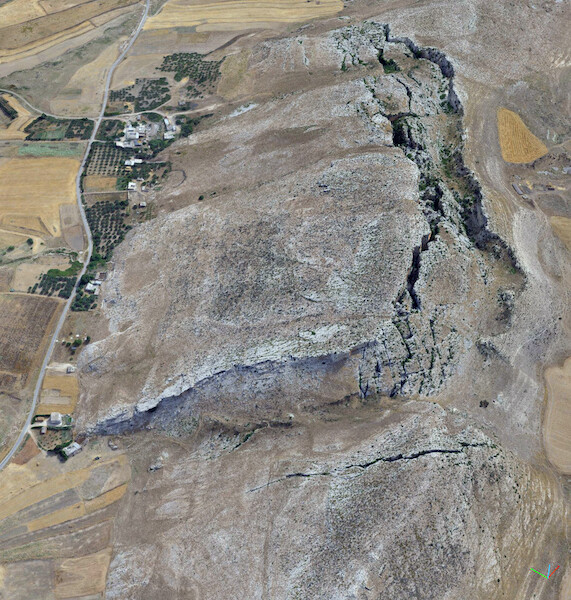13 October 2021
The Chgega landslide in Tunisia
Posted by Dave Petley
The Chgega landslide in Tunisia
The Chgega landslide is an interesting and unusual slope failure located close to the village of Tahint in the Mateur region of northern Tunisia (36.901, 9.521 is the location – it is very clearly visible on Google Earth). Every landslide is of course unique, but this one is quite unusual. The landslide is described in an article in the journal Remote Sensing (Gaidi et al. 2021), in which the authors have used a variety of remote sensing methods to examine its movement. There is also a short summary on the Terradue website, which includes this image:-

Aerial image of the Chgega landslide in Tunisia. Image posted on the Terradue website.
.
The landslide consists of a block of limestone that is 900 metres long and 400 metres wide sliding over a lower layer of clays and marls. The hill has a peak of 553 m asl, whilst the toe of the landslide is at about 395 m asl, giving a vertical extent for the Chgega landslide of about 160 m. The landslide is characterised by a rear scarp in the form of a huge graben, which is about 800 m long and up to 120 m wide.
This area of Tunisia is subject to active tectonic deformation, and as a result has a significant level of seismic hazard. Documented earthquakes in this area of Tunisia include major events in 410 AD and 856 AD. Thus, it is possible that the landslide was initiated by, and indeed principally moves during, earthquakes.
In their research, Gaidi et al. (2021) used a combination of INSAR and photogrammetry to measure the annual movement of the Chgega landslide. They concluded that over 4.7 years it moved a total of about 1 cm. Thus, this is a landslide that in asiesmic conditions is undergoing very slow creep type movements.
The Chgega landslide is a beautiful example of a spreading type of landslide. It’s accessibility means that it is worthy of further investigation. I shall certainly be adding it to my bucket list of places to visit when I retire.
.
Reference
Gaidi, S., Galve, J.P, Melki, F. et al. 2021. Analysis of the Geological Controls and Kinematics of the Chgega Landslide (Mateur, Tunisia) Exploiting Photogrammetry and InSAR Technologies. Remote Sensing, 13 (20), 4048; https://doi.org/10.3390/rs13204048.


 Dave Petley is the Vice-Chancellor of the University of Hull in the United Kingdom. His blog provides commentary and analysis of landslide events occurring worldwide, including the landslides themselves, latest research, and conferences and meetings.
Dave Petley is the Vice-Chancellor of the University of Hull in the United Kingdom. His blog provides commentary and analysis of landslide events occurring worldwide, including the landslides themselves, latest research, and conferences and meetings.
I wish I knew where Google Earth got the DEM they drape their imagery upon. This graben looks like it starts on the back side of the ridge, then transitions across it to the NE. Here in the US, I think they use the USGS DEM reverse-engineered from 7.5′ Quadrangles.
I also wonder if the apparent fan deposits along the toe of the slope may play a buttressing role? There are several old Quaternary slides identified in the Monterey Formation (siliceous shale) east of Monterey CA in Seaside that are probably buttressed by Pleistocene dune fields . In another life, I was part (field grunt) of a program to evaluate their stability. Using drill core data, we could only get the slide model to move if it toed out far below the existing surface.
I also wonder if the apparent fan deposits along the toe of the slope may play a buttressing role? There are several old Quaternary slides identified in the Monterey Formation (siliceous shale) east of Monterey CA in Seaside that are probably buttressed by Pleistocene dune fields . In another life, I was part (field grunt) of a program to evaluate their stability. Using drill core data, we could only get the slide model to move if it toed out far below the existing surface. You better click here to find the best trucking company
I also wonder if the apparent fan deposits along the toe of the slope may play a buttressing role? There are several old Quaternary slides identified in the Monterey Formation (siliceous shale) east of Monterey CA in Seaside that are probably buttressed by Pleistocene dune fields . In another life, I was part (field grunt) of a program to evaluate their stability. Using drill core data, we could only get the slide model to move if it toed out far below the existing surface. https://ulive.chat/en/p